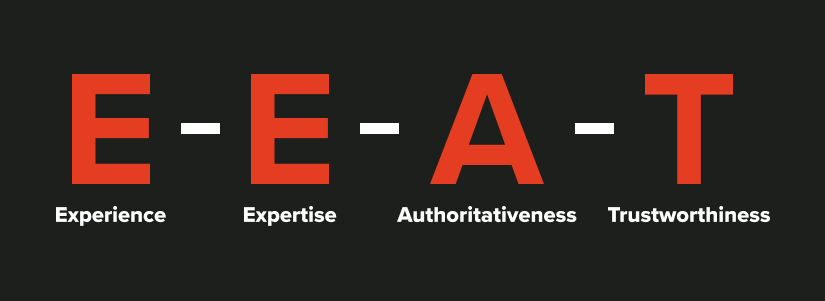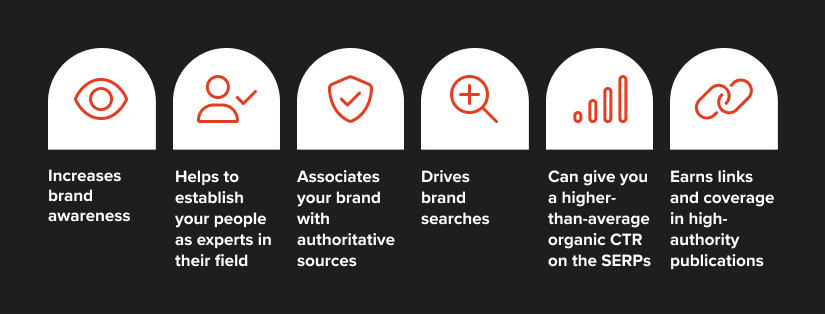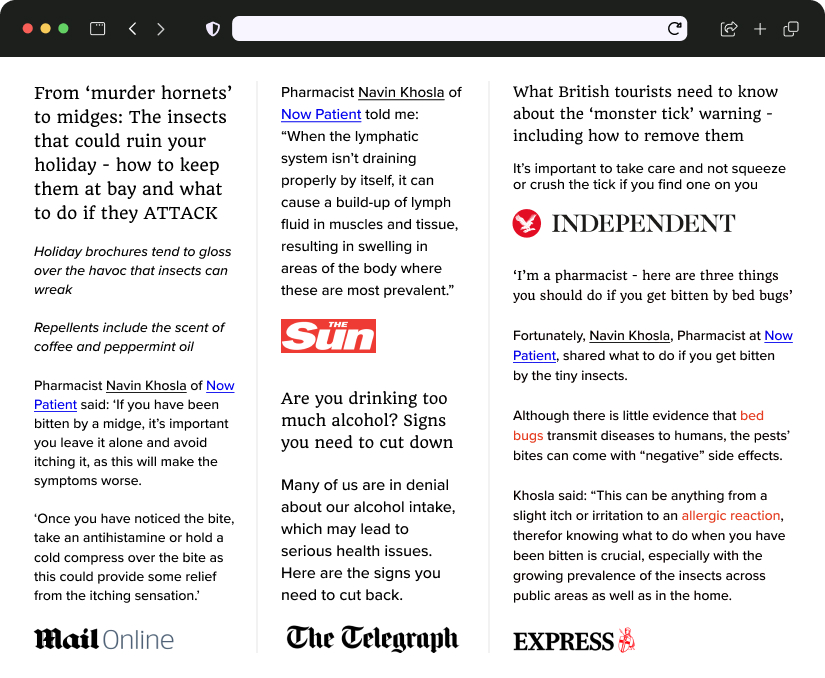
E-E-A-T is not a new topic.
In fact, I am sure you’ll have attended many online and in-person events from SEOs and digital PRs where they have mentioned or even honed in on E-E-A-T.
And rightly so; it has been a huge topic since Google added the extra “E”, which stands for experience, towards the end of 2022.
When we think about why this is such a big topic, it makes sense that Google is keen to push authoritative and trustworthy sites higher up in the SERPS when we consider that consumers will stop searching if poor-quality information is being offered up.
But digital PR plays a much bigger role in demonstrating E-E-A-T than you probably think. If you’re not leveraging digital PR to build E-E-A-T signals, you’re missing out.
In a previous guide, we’ve already discussed the role that digital PR plays in demonstrating E-E-A-T, but how do we do this in practice? How can we adapt our digital PR strategies to enhance our E-E-A-T profiles?
In this guide, I’ll be answering just that.
I’ll share practical, actionable tips that you can use to ensure your digital PR strategies help you demonstrate E-E-A-T at the content, author, and brand levels to maximise the effectiveness of your overall organic growth campaign.
What is E-E-A-T?
Before we dive into how to adapt your strategies, it’s important to understand what E-E-A-T is.

E-E-A-T stands for Experience, Expertise, Authoritativeness and Trustworthiness. It’s how Google’s Quality Raters evaluate the search engine’s ranking systems and assess the quality of a page. This ensures that the SERPs return helpful and relevant results, meeting the searchers’ expectations.
If you want to explore the topic even further, our managing director, James, has put together a guide on everything you need to know about E-E-A-T.
Why digital PR for building E-E-A-T signals?
Digital PR is one of the most effective ways of building E-E-A-T signals, and if you work in digital PR, it’s important that you understand its role and how you can use it to your advantage.
Why should you be using digital PR to demonstrate E-E-A-T? Because it…

What strategies should digital PRs be using to enhance E-E-A-T signals?
1. Earning backlinks from relevant publications
Earning backlinks from third-party sites is nothing new for digital PRs, but earning regular links from relevant titles helps to demonstrate authoritativeness.
While this might not be new information, it’s the type of links secured that demonstrate the authority we’re interested in here.
While earning links and coverage at scale definitely has its place, Google has said they judge websites placing high importance on trustworthy and helpful content – so links from hyper-relevant titles will have a greater impact on E-E-A-T signals.
In fact, the latest Google documentation leak clearly shows that Google could be ignoring links from within content that isn’t deemed relevant.
Relevance in Digital PR is a hot topic at the moment. If you’re unsure about what is relevant to your brand or your client, read our guide on relevancy in Digital PR.
2. Digital PR campaigns
It feels as though the industry as a whole seems to be producing fewer hero campaigns and instead focusing efforts more on thought leadership and expert insights.
However, for the right client, campaigns still have their place in a digital PR strategy (and you can quote me on that!) and they help to demonstrate trustworthiness.
Campaigns absolutely still need to be relevant to your brand or your client, but they will naturally be a little further removed from the brand’s core offering – widening the scope and allowing us to earn relevant links and coverage at scale.
Data-driven hero campaigns especially provide you with an opportunity to position your brand or your client as an industry leader, cement your brand as an expert, increase reach and provide commentary on your key topics through reports, studies and expert commentary.
Gone are the days when articles were published under admin. It’s important that campaigns published on a client’s website are published by an author to demonstrate E-E-A-T further.
For example, for one of our medical clients, we always get a specialist to look over the campaign, and so when we publish it on site, we state, “Medically reviewed by [Insert expert].
3. Author pages
Author-level E-E-A-T is one of the most important for digital PR. Authorship is all about building and demonstrating the reputation and credibility of your authors and experts, both on and off-site.
A great way to do this is to have in-depth author profile pages on your site.
These pages need to demonstrate why and how the person is an expert in their field and include links back to their social media pages and latest blog articles. This page signals to Google that this person is an expert in their field.
Here is a great example of an in-depth author page for one of our clients.
As you can see from the example below, this author page includes an about section that clearly demonstrates why Navin is an expert in his field. It also includes his education history, a link to his license details, his affiliates, and his professional expertise.
Moreover, links to his LinkedIn page and his latest blog articles help build those E-E-A-T signals for Google.

4. Pitching out expert insights from your subject matter experts
Following on from creating author pages, digital PR takes this one step further, as we can then position our clients as experts in their field through a reactive strategy and land coverage for our clients through this tactic.
Links from relevant and high authority publications pointing to your author’s profile page are a strong signal that they’re trusted – a strong E-E-A-T metric.
To ensure journalists are linking back to your author’s profile page, simply include a link to these pages in your pitch when sending out expert commentary.
In 2024, every digital PR pitch you outreach should also include expert commentary, not only to demonstrate E-E-A-T but also because this is what journalists are looking for more than ever.
You do not need hundreds of links to your author’s profile pages to demonstrate that they are a trusted source; instead, a handful of hyper-relevant links are enough to build strong E-E-A-T signals.
If you still need to implement this as part of your digital PR strategy, look at your author profiles on-site, update them if needed and include links to these pages in your pitches moving forward!

5. Using thought leadership to demonstrate experience and expertise
Thought leadership is similar to expert commentary, but it goes one step further. Thought leadership is where your brand’s leading industry experts publish insightful and informative articles on the brand’s website covering in-depth topics within their industries, leveraging their opinions as representatives of the company, offering up new ideas and pushing conversations to better their industries.
Thought leadership requires planning and ensuring experts have genuine insight to share, but it presents a valuable opportunity for people within your business to demonstrate expertise, build trust with your existing audience while tapping into a new audience, and build the reputation of the brand.
Furthermore, according to research, 60% of business decision-makers said authority figures could directly lead to closed-won deals and that it convinced them to buy a product or service they were not thinking about before. Therefore, we know that thought leadership can directly impact sales.
As digital PRs, we want to position our clients and their experts as the ‘go-to’ experts on a subject and help them become sought after in their industry and beyond.
6. Utilise your client’s existing on-site content
More often than not, our clients have blogs full of expert commentary, tips and guides which sit on their site but have never been utilised for digital PR.
As part of your digital PR strategy, you need to comb through this onsite content and see what you can repurpose and push out to press and make these assets work harder from an SEO perspective, earning links and driving traffic.
Importantly, make sure these blog posts are written by real people (not just admin!) and include an internal link back to their author pages, this helps to strengthen those E-E-A-T signals further.
7. Shout about brand announcements!
This one might feel a bit more like traditional PR, but it’s important to remember that digital PR has always had a blend of traditional PR thrown in the mix – let me explain!
While we focus on high authority and relevant publications, it’s very easy to overlook both your brand’s local area and industry press, however, these publications are a great opportunity for building those all-important E-E-A-T signals at the brand level.
So, if you have a brand announcement or want to shout about your company’s success, publications in your local geographical area and your industry will be more than likely to cover it.
The benefit? This coverage will be exclusively speaking about your brand and will more than likely include a link back to your site online, but they’ll usually cover it in print too, which is great for brand awareness.
Final thoughts…
As one of our Digital PR managers, Millie, recently wrote in her blog on quality over quantity, digital PR is no longer just about the volume of links. Changing your digital PR strategies to focus on building E-E-A-T signals is the best way to generate impact results that will have a real impact on your site.




